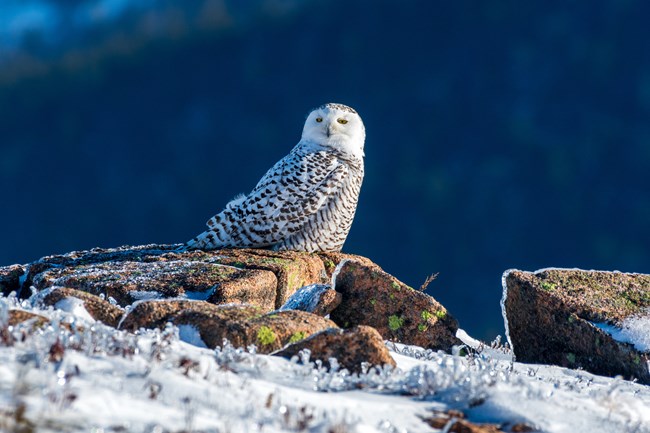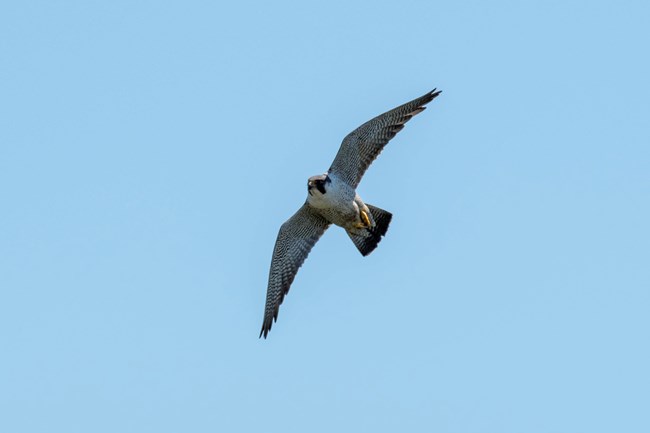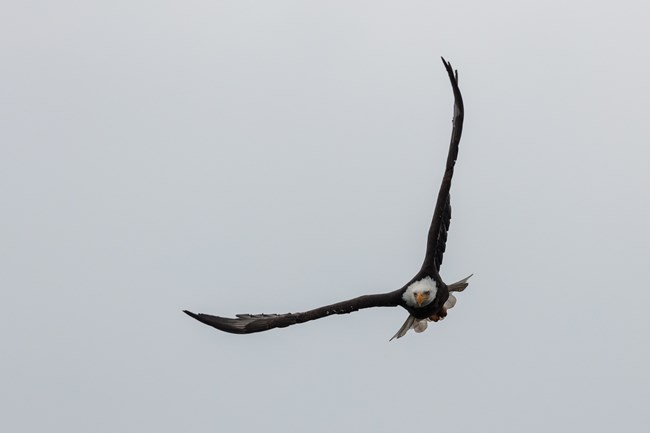Last updated: October 16, 2020
Article
Riding the Winds: Hawk Watch in Acadia National Park 2020

NPS Photo
10/11 – 10/17
While it seems like the hawk watching season just started here in Acadia, it is now coming to a close. This season was a good one, where we saw a lot of species diversity and ended with almost the same numbers of migrants as last year. This fall, volunteers and scientists from the Schoodic Institute came together to clock a total of 237 hours of counting, and 2754 raptors. Last year we observed 2838 raptors and counted until October 26th. This year, we saw an increase of 700 broad-wing hawks compared to last year, and counts of both kestrels and sharp-shinned hawks decreased.
One great thing to look forward to this winter in the park are birds that migrate from the arctic to use Acadia as their winter habitat. One of these species is the snowy owl, a large white raptor with yellow eyes that breeds in the treeless arctic tundra. They thrive in open spaces, something that is supplied by many of Acadia’s mountaintops. They mainly feed on small mammals but are agile enough to capture small birds in flight. So, if you decide to brave the Maine winter, keep your eyes peeled for a spot of white against the mountainous backdrop. Just make sure to stay a safe distance away, and always keep pets on a leash!
Migration Totals (10/11-10/1
Turkey Vulture: 18
Osprey: 2
Bald Eagle: 7
Northern Harrier: 5
Sharp-shinned Hawk: 50
Cooper’s Hawk: 1
Northern Goshawk: 2
Red-tailed Hawk: 4
American Kestrel: 28
Merlin: 9
Peregrine Falcon: 4
Unknown Accipiter: 1
Unknown Buteo: 1
Unknown Raptor: 5
Total: 137
Season Total: 2754

Emma Forthofer, NPS, Friends of Acadia
10/4 – 10/10
Raptor migration, like fall leaf color, is appearing to be past its peak time. This week yielded the lowest count since the beginning of September, signaling that many raptors have reached points further south by now. We still saw a high species diversity, with 9 different species observed during the 5 days where counts were officially conducted. One species we saw an unusually high proportion of were peregrine falcons, the fastest animal on the planet!
Peregrine falcons nest in Acadia in a few different cliffside locations, including the sheer east face of Champlain Mountain where the Precipice trail is located. Like all falcons, peregrines are designed for speed and maneuverability with their narrow, pointed wings. While diving to catch prey in midair, peregrine falcons can clock in at over 200 miles per hour! This is so fast that a diving peregrine is nearly impossible to follow with either the naked eye or binoculars. Acadia’s peregrines have a remarkable story of success, after becoming locally extinct by the 1960s. Since 1991, more than 160 chicks have been born here, which is great news for peregrine populations. They feed on other birds, and a preferred food source are gull chicks found on nearshore nesting islands. Egg Rock, located off the coast by Champlain Mountain, is a peregrine falcon all-you-can-eat buffet in the springtime!
Migration Totals (10/4-10/10)
Osprey: 9
Bald Eagle: 4
Northern Harrier: 8
Sharp-shinned Hawk: 8
Cooper’s Hawk: 1
Broad-winged Hawk: 1
American Kestrel: 6
Merlin: 2
Peregrine Falcon: 6
Unknown Raptor: 3
Total: 48

NPS Photo
9/27-10/3
The last few days of September brought poor weather to the Cadillac Mountain Hawk Watch site, and no official counts were conducted. Fog, mist, rain, and south winds do not make good migrating conditions for raptors. The first raptors logged of this week were on October 1st, when a turkey vulture and a peregrine falcon were observed migrating. Many of the turkey vultures spotted throughout the earlier weeks of hawk watch are local birds that hang around the island for the majority of the year. They usually begin to migrate in October, with some not leaving until early November. In the spring, we start to see them return as early as late February! This is remarkable because as recently as 30 years ago there were no turkey vultures to be found in Acadia, and now they are everywhere! Due to climate change, many species’ ranges have expanded from where they were decades ago, including birds, mammals, and fish. Black vultures are one species of bird we are expecting to see more often in the near future, as their range continues to expand north.
The last day of this week’s counting, October 3rd, proved to be the best migration day in a while. A west-northwest wind helped funnel raptors over Cadillac, and the day ended with a total count of 122. As usual, sharp-shinned hawks and American kestrels took the numbers prize, but we also had a good showing of osprey! These ospreys have a long journey ahead of them, with the majority flying to wintering grounds in Central and South America.
Migration Totals (9/27-10/3)
Turkey Vulture: 7
Osprey: 11
Bald Eagle: 3
Northern Harrier: 5
Sharp-shinned Hawk: 44
Cooper’s Hawk: 1
Northern Goshawk: 1
Broad-winged Hawk: 1
Red-tailed Hawk: 1
American Kestrel: 34
Merlin: 3
Peregrine Falcon: 3
Unknown Raptor: 10
Total: 124

NPS / Jacob W. Frank
9/20 - 9/26
The north winds we had through much last week continued just until the end of last weekend. For the start of a new week, Sunday the 20th gave Cadillac Mountain hawk watchers 472 raptor sightings. With Monday came northeast winds, and far fewer raptors. Unfortunately, the rest of the week has offered relatively low raptor sightings, largely because of unfavorable winds.
Out of the 472 raptors seen on Sunday, 60% of them (284) were broad-wing hawks. This species is one of the most common migrants we see from Cadillac. They are part of the buteo family, like red-tailed hawks, and can often be seen traveling in large kettles, using thermal updrafts to spiral up into the sky. The name “kettle” comes from a tea kettle, where the rising steam spirals up out of the spout. Traveling hawks use these spirals of warm air that form above mountains to give them a free height boost without needing to flap their wings.
Monday the 21st provided us with a look at a kettle of 8 bald eagles, complete with both adults and juveniles. The adults are easy to spot with their white heads and dark bodies, but young eagles don’t display this same plumage until they are 5 years old. Here on Mount Desert Island, there are both bald eagles that live locally year-round, and others that migrate further south to escape the Maine winter.
Migration Totals (9/20-9/26)
Turkey Vulture: 23
Osprey: 11
Bald Eagle: 21
Northern Harrier: 18
Sharp-shinned Hawk: 132
Cooper’s Hawk: 4
Northern Goshawk: 2
Broad-winged Hawk: 286
Red-tailed Hawk: 4
American Kestrel: 74
Merlin: 10
Peregrine Falcon: 1
Unknown Accipiter: 1
Unknown Falcon:
Unknown Raptor: 12
Total: 599
9/13 – 9/19
Today wrapped up an absolutely stellar week for the Cadillac Mountain Hawk Watch. With a total of over 1000 migrants counted this week, there was no shortage of birds to be seen! We had two “banner” days, which were characterized by north winds, low humidity, and sunshine! Tuesday the 15th saw 585 migrants, the largest day we have had so far this season. Broad-wing hawks and sharp-shinned hawks dominated that day’s numbers, which is typical for here in Acadia. We did have an unusually high number of Cooper’s hawks pass on Tuesday, compared to the number of sharp-shinned hawks. Usually here in Acadia we see approximately one Cooper’s hawk for every 100 sharp-shinned, but there were 7 Cooper’s for 153 sharp-shins. Saturday the 19th was the second banner day, and numbers were boosted by large kettles of raptors were seen off to the east. At one point, a distant kettle of about 30 broad-wing hawks appeared over Schoodic Mountain for a short time before disappearing into the clouds.
The 19th awarded us our first Northern Goshawks of the season, which was a real treat. Goshawks are the scarcest member of the accipiter family we see here; in the last decade, we only counted 57 total. They are fairly large raptors, with the females being noticeably larger than the males. Unlike the much more common sharp-shinned hawk, which only eats other birds, goshawks prey upon small mammals like squirrels and rabbits as often as birds.
Migration Totals (9/13-9/19)
Turkey Vulture: 10
Osprey: 37
Bald Eagle: 25
Northern Harrier: 18
Sharp-shinned Hawk: 330
Cooper’s Hawk: 10
Northern Goshawk: 2
Broad-winged Hawk: 563
Red-tailed Hawk: 8
American Kestrel: 172
Merlin: 12
Peregrine Falcon: 8
Unknown Falcon: 4
Unknown Raptor: 11
Total: 1,210

NPS / Jessica Weinberg McClosky
9/6 – 9/12
Migration is definitely picking up here in Acadia, with multiple days in the double digits for migrants! The morning of September 6th was sunny with gentle north winds, a great combination for migration. 29 raptors passed by before the winds dropped off in the late morning, along with raptor movement. The middle of the week was pretty barren, again due to unfavorable wind directions. On days when the winds are headed in the wrong (southerly) direction, raptors choose not to migrate to avoid the energetic cost of flying into a headwind all day. Instead, they hunker down to recoup from days when they were flying, taking time to hunt and rest.
The real winner of a migration day was Friday the 11th. Strong winds coming in from the north drew both raptors and hawk enthusiasts to Cadillac Mountain in droves. Counting officially started just before 9am, and almost immediately the American kestrels started pouring in. By the time counting concluded at 3pm, we had tallied 350 migrants of 9 confirmed species! Sharp-shinned hawks (73), Broad-winged hawks (126), and American kestrels (90) made up the majority of the day’s numbers, which is typical here at Cadillac Mountain. American kestrels predominantly spend the winter in the southern United States, with some migrants going as far as Central America. Sharp-shinned hawks migrate a bit further on average, with the majority ending up in Mexico and points further south in Central America. The real winners of migration distance are the broad-winged hawks, however, which migrate from areas in the United States and Canada as far as the Amazon River basin! Sometimes thousands of these hawks can be seen at once headed south along mountain ridges, lake shores, and ocean coasts.
Migration Totals (9/6-9/12)
Turkey Vulture: 8
Osprey: 34
Bald Eagle: 5
Northern Harrier: 11
Sharp-shinned Hawk: 125
Cooper’s Hawk: 1
Broad-winged Hawk: 159
American Kestrel: 115
Merlin: 5
Peregrine Falcon: 1
Unknown Accipiter: 5
Unknown Raptor: 15
Total: 484

NPS Photo
8/30 - 9/5
August count totals went out with a bang here in Acadia! On the last day in August, we observed 71 raptors, with incredible diversity making the day all the better. A light northerly breeze was the deciding factor in the day’s success and left the counters with spirits soaring as high as the kettle of 7 bald eagles observed around noon. A single red-shouldered hawk was observed just after the counting started, which was a treat as Acadia is located at the very northern part of their range and they are a rare sight here. The rest of the week returned to low early migration season numbers, compounded by south or east winds most days, and the weekly total topped out at 107 raptors.
September 3rd gave us the first northern harrier of the season, a beautiful female who flew close overhead, almost as if she were showing off. Saturday the 5th was the second largest count day, with 21 raptors observed. West winds overnight and into the morning brought in a few extra migrants, including three more northern harriers and eight American kestrels! Northern harriers are one raptor species that are beginning to experience population declines, and one suspected cause is habitat loss. They hunt small rodents in open wetlands or grasslands, but human development and reforestation is reducing the amount of suitable areas for them to hunt. Data from hawk watch sites around the country can be used to determine the best ways to help these raptors though, so they can be conserved into the future!
Migration Totals (8/30-9/5)
Turkey Vulture: 7
Osprey: 16
Bald Eagle: 14
Northern Harrier: 4
Sharp-shinned Hawk: 10
Red-shouldered Hawk: 1
Broad-winged Hawk: 20
Red-tailed Hawk: 4
American Kestrel: 18
Merlin: 3
Unknown Buteo: 3
Unknown Raptor: 7
Total: 107

NPS/Patrick Kark
8/23 – 8/29
Week two of Hawk Watch in Acadia followed similar trends to the first week of counting. In general, we observed low numbers of migrating raptors, which is still not unusual for this early in the season. We expect things to pick up this coming week and are excited to see what the future holds! The one day that provided us with desired northwest winds did see the highest raptor counts thus far, with 11 migrants counted. Unfortunately, we were unable to identify 6 of the total 11 due to their distance from the counting site and overall flight path which took them past the south side of Mount Desert Island. This week also provided us with slightly higher species diversity than last week, and we added turkey vulture to the migrating species list. We had only previously observed local turkey vultures this season. Over the course of a typical season, we observe up to 12 different species, which means more diversity is sure to be on the way!
We did observe a remarkable diversity of non-raptor birds, which similar to last week included many songbirds and gulls. The most interesting visitors included a purple martin (part of the swallow family), 6 northern rough-winged swallows, and a couple of common nighthawks, which are not a hawk at all, but rather part of the nightjar family.
Migration Totals (8/23-8/29)
Turkey Vulture: 2
Osprey: 2
Bald Eagle: 1
Sharp-shinned Hawk: 3
Broad-winged Hawk: 5
American Kestrel: 1
Unknown Raptor: 6
Total: 20

NPS, Friends of Acadia Photo
8/14-8/22
Now in its 26th season, the first week of Acadia’s 2020 Hawk Watch on Cadillac Mountain gave raptor counters a taste of what the coming weeks will have to offer! This week had a slow start, with 15 migrating raptors counted between August 16th and August 22nd. Low numbers are typical for this early in the migration season, as raptors are only just beginning to move in the third week of August. Daily raptor count totals usually peak in mid-September, with some days tallying nearly 1000 birds. South winds and rain worked against us nearly half the week, further hindering our counting efforts. The best conditions for viewing migrating raptors on Cadillac Mountain are clear skies and northwest winds. The birds ride these helpful winds up and over Cadillac, getting a welcome boost in their southward journey.
Many local turkey vultures, passerines (songbirds), and seabirds were observed in place of migrating raptors, with strong showings by both cedar waxwings and herring gulls. One osprey was spotted on the preliminary count day; osprey are unique because they are the only raptor to eat a diet of exclusively fish. We are looking forward to viewing more raptors as we move into late August and early September!
Migration Totals (8/14-8/22)
Osprey: 1
Bald Eagle: 1
Sharp-shinned Hawk: 6
Broad-winged Hawk: 4
American Kestrel: 2
Unknown Raptor: 1
Total: 15
